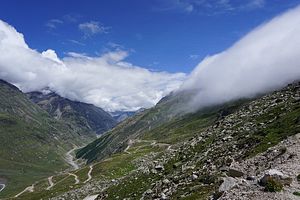This week, NDTV and The Print both ran exclusive satellite imagery-based glances at Doklam, the Himalayan site of this summer’s standoff between Indian and Chinese troops that remains ongoing, albeit at a reduced intensity. According to NDTV, “New satellite images of the Doklam area to the east of Sikkim reveal that the Chinese have expanded multiple stretches of road in the disputed area, just a short distance from the site where Indian and Chinese soldiers faced off for 70 days earlier this year.” The Print‘s analysis supports that conclusion.
Having reviewed daily satellite imagery of the Doklam site through Planet, there’s no contesting against that conclusion. At some point after the start of this summer’s standoff in June, the Chinese People’s Liberation Army (PLA) improved and potentially added new pieces of track and road on the Dolam plateau, approximately one kilometer from the “turning point” that was the nexus of this summer’s standoff. These newly constructed roads, however, aren’t to be confused with the as-yet-unconstructed planned road extension that spurred the Indian Army to cross the watershed line into Doklam in June in the first place. Instead, these roads are alternative pathways connecting a long-standing Chinese road that has been in use at Doklam since at least 2005 and almost certainly much earlier.
The exact timing of the construction of the roads highlighted by NDTV and The Print is interesting, too. Though NDTV suggests the roads were constructed in October, Planet’s imagery of the Doklam site reveals evidence of their existence as early as late-August, just days before India and China announced the ‘disengagement’, by which their troops would both retreat their positions, but remain at Doklam. Imagery from August appears obscured by clouds, but there’s enough evidence to conclude that the PLA likely began construction on these paths at some point between late-July and mid-August, at the height of the standoff.
It’s unclear if the PLA’s decision to construct these pathways was informed by an expectation that the standoff would turn into a months-long affair, necessitating a robust wintertime presence in the Dolam bowl. Now, with the PLA and the Indian Army both dug in for the winter at Doklam, these pathways provide an important benefit as far as supply and logistics are concerned. The long-standing single pathway at Doklam requires constant maintenance in the winter months and, with reportedly hundreds of PLA troops still in the area, alternative pathways for logistics and replenishment may serve and important purpose. These paths could also enable longer-term ranging and patrol activities for the PLA in the area.
No one knows just how large the PLA’s presence at Doklam might be six months or a year from now, but these new tracks provide the foundation for a more permanent presence in the area. Before this summer’s standoff, the PLA would intermittently patrol the area and enter into the occasional scuffle with the Royal Bhutanese Army or an Indian Army patrol. Now, with hundreds of troops dug in for the winter, with equipment in tow, India must be prepared for a permanently transformed state of affairs to the east of its border post at Doka La, along the Sikkim-Bhutan border.

































